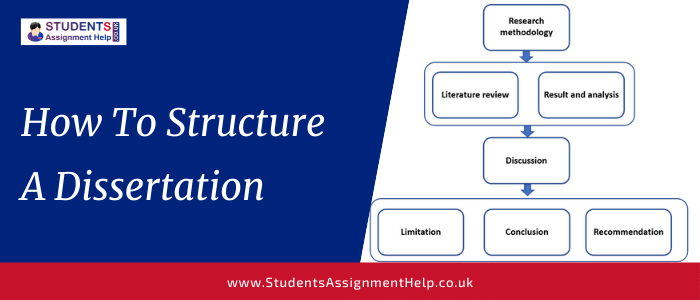How to Structure a Dissertation
A dissertation is a long piece of writing that shows research work on a particular course exploring the urge of digging out the fact behind a subject area. A dissertation refers to the report, written by PhD. a student on a particular subject area explaining the motives, processes, and outcomes of the research undertaken during the course.

The dissertation shows the relation between concepts considered while creating imagery on the flow the variables are moving. It also delivers the information on the tools and techniques to be used by the students to generate the results by answering a particular question (Research question) that reveals the key purpose of conducting the study.
Critical Elements of a Dissertation:
Before writing a dissertation, the researcher needs to be aware of a few critical elements and their relevance to the research.
Variables: It is generally found in the topic/title of the dissertation showing the concepts/subjects, undertaken to establish the link between those. For example, “The impact of COVID-19 on Employee motivation of the UK retail sector”. Here, variables are COVID-19 (Independent) and Employee Motivation (Dependent) showing the impact of one on another.
Research question: It reveals the key inquiry that the researcher raises to develop an in-depth understanding of the subject area undertaken. It is developed on the topic framed with key variables.
Methods: Methodology is a vital part of a dissertation that drives the researcher towards selecting relevant data (Primary/Secondary/Mixed) on the subject area leading to initiate in answering the research question(s). Before selecting methods, the nature of the topic should be evaluated to know which information type would deliver the best understanding.
How to Make a Good Dissertation Structure:
Developing the structure of a dissertation depends on the subject area of the research paper, academic rules, and the specific outline recommended in the course. For instance, the structure of a literature paper differs from scientific research in terms of its nature and the types of data to be considered and used.
There are various guidelines to be followed in writing a dissertation which could be divided into some prime sections. A standard dissertation consists of 5 chapters/sections where the researcher needs to maintain a flow of the sections by linking one to another to construct such an elongated but good research paper.
1. Dissertation Title:
In other words, it is also named as the cover page where you will include the Topic of the dissertation, Student name, Student number, Word count (optional), and assessor name (optional). You can use a good cover page template for a good representation or the university cover page
2. Dissertation Abstract:
The abstract of a dissertation is the summary that comprises of the central idea of the research followed by key information on methods used and results received. The abstract can be written in different small points like:
- The central idea of the topic
- Methods used
- Results derived
3. Dissertation Acknowledgement/Declaration:
It is an optional section in the dissertation to show gratitude to the individuals associated with the research for their valuable contribution. Eventually, Declaration is often instructed to be written revealing your work authenticity and confession regarding research validity
4. Dissertation Table of contents/Index:
TOC makes the paper for the reader to find out different points in such an elongated piece of paper. It shows a page number of each section and subsection followed by the same format for the diagrams and tables included in the dissertation separately.
5. Dissertation Introduction:
This chapter introduces the paper with background, rationale, scope, problem statement, aims, objectives, questions, and hypothesis. The background should introduce the variables and their relevance to be integrated into the research. Here, we can define and explain the variables from different views to develop a strong conceptual platform in mind regarding the subject.
The rationale should explore the question “Why is the research being conducted?”, “What is the relevance of conducting it”. “What is the key problem to be synthesized through the research?”
Framing a set of good objectives needs a sound understanding of What and Why am I going to do this research. What is the main question that I am willing to answer? Objectives should be focused and narrowed down to smaller areas of the topic where meeting objectives can together answer the research question.
6. Dissertation Literature Review:
Literature Review can also be termed a Review of Literature which means rethinking the existing theories, models, concepts, and opinions in a wrapper of the particular dissertation topic. Thus, before writing a dissertation, you ought to have an extensive comprehension of consulting theories, concepts, and different opinions. A literature review can be of different types like Empirical, systematic, Thematic, etc. depending on the demand of academic rules and university norms. The approach of the literature review also differs from each other’s based on nature.
For instance, a Systematic review is more precise and focused on searching for valid resources to strengthen the knowledge of the researcher. However, thematic review demands to development of several themes from the topic to search for relevant materials (Theories and data) for further discussion.
Remember, Literature Review should
- Reflect on a comprehensive study followed by gathering sources
- Breaking down the sources into different heads and subheads
- Discussion of different themes in the context of previous articles and different research
- Drawing the association of different points with the topic area
7. Dissertation Methodology:
The methodology of a dissertation shows the nature of the research and in which direction the research should be driven. It specifies methodology based on a coherent and specified research paper. The section should include:
- The types of research like Empirical, primary, Secondary, Qualitative, Factual, Theoretical, etc.
- Type of data to be taken (Primary/Secondary/Both)
- The motive of the researcher behind the research and dissertation
- Data collection process and different data analysis methods
- Specific sampling and population to be considered
Note: You need to write on the justification of taking a particular method in the research rather than defining it. For instance, if you are taking primary data for the dissertation, write down which model you have gathered and why such data is most relevant for your dissertation. You can decide the data type and nature of the dissertation based on the topic and the availability of sources of data for that particular subject.
Further: Methodology should be approved by the research proposal
8. Dissertation Findings and analysis:
This section reveals the insight of different strata of collected information to get the results aimed to be revealed. According to the universities, these sections are currently subcategorized into two different chapters:
Results:
The result of a dissertation should show the conclusion of the dissertation. It generally reveals the representation of the collected data either through graphical format or explanatory format. For instance result section of primary quantitative research represents graphs of participants’ reviews. Qualitative primary research might represent the interviewee transcript or decoded transcript. You need to remember that result is the face of the deriving conclusion that reveals what the conclusion should be.
The section needs to be developed through different points on the data gathered followed by an explanation of those results like what happened and what are the consequences.
Discussions:
The discussion gives you the space to evaluate the story behind the results. You can dig out whether the research and findings have successfully stood out to your expected outcomes. Here, you ought to work on more details (Why happened, what would have been, what could be, etc.), and link your findings with literature through direct referral to a statement of an author you have mentioned in the literature review section.
Discussion stands out to reveal whether your research is one the way to accomplish your objectives. Link the findings with theory whether the data fit the theoretical framework and conventional knowledge developed in the literature.
For example- “The result shows non-monetary compensation motivates the employees more than monetary incentives. Supporting to this result, Author (2019) opined …………./Author (2019) proposed a different and opposite projection through a comment that………………………….”
9. Dissertation Conclusions and Recommendations:
Conclusions indicate the success of the dissertation. Here, you will triangulate data, literature, and objective/question to indicate the completion of the research. The conclusion is different from the summary. Here, you will initially summarise the findings followed by deriving the hypothesis to establish the relationship between variables.
Key points to be followed in this chapter are as follows:
- Mention research questions/objectives directly to discuss whether it is met/answered properly
- Relate findings and derived inference with objectives
- Find out the loopholes for recommendations
- Use the SMART framework to recommend action for the research areas
- Add “Limitations” and “Future Scope of the Research” after recommendations
10. Dissertation References:
It reveals the list of sources you went through and used in the research. Therefore, use only references having access to the full document. It should be represented in a specific format (Harvard, APA, MLA, Oxford, etc.) based on location and university guidelines. The list should be in alphabetical order and
11. Dissertation Appendices:
This section comprises the supportive evidence of the dissertation that assists in analyzing data where it is not directly included in the main sections of the dissertation step by step. For example, Specific reports, Questionnaire, Transcripts, and Google form links come under this section
























